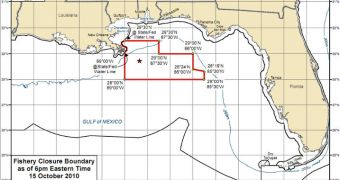Officials at NOAA announced that a new swath of ocean has been reopened to commercial and recreational fishing. There were no contaminants found in the region to justify keeping it closed anymore.
The decision was taken by experts at the US National Oceanic and Atmospheric Administration (NOAA), the Food and Drug Administration (FDA), and representatives from Gulf states.
The reopened area covers about 6,879 square miles of Gulf of Mexico waters, and is located an estimated 180-200 nautical miles south of the Florida panhandle, the agency reports.
It stretches between the Florida-Alabama state line and Cape San Blas, Florida, and its reopening represents the ninth time NOAA has taken this decision since July 22.
“Each reopening is a reassuring sign that areas once impacted by oil can again support sustainable fishing activities,” explains NOAA Administrator Jane Lubchenco, PhD.
“Tourists and consumers should know most Gulf waters are open for fishing and seafood from these waters is safe to eat,” adds the official, who is also the US under secretary of commerce for oceans and atmosphere.
Statistically speaking, the reopened area covers a total of 3 percent of federally-controlled waters in the Gulf. It also represented about 29 percent of the formerly closed area, as established on November 5.
The last time oil sheens have been spotted in the area was on July 13, and subsequent analysis failed to uncover any more sings of contamination.
According to NOAA experts, the region is located about 110 miles southeast of ground zero of the Deepwater Horizon incident, which began unfolding on April 20, 2010.
A semi-submersible drilling rig operated by British Petroleum exploded south of Louisiana coastlines, and sunk into the waters on April 22, triggering the worst environmental disaster in US history.
Millions of barrels of oil were spill through three wellheads, and it took months for authorities to plug those holes. Decontamination measures were applied throughout the effort.
Slowly, swaths of the closed area began being reopened, as studies demonstrated the lack of risk in consuming fish harvested from those locations.
“NOAA will continue to take samples for testing from the newly reopened area. The agency will also continue dockside sampling to test fish caught throughout the Gulf by commercial fishermen,” the agency states.
“NOAA and FDA are working together on broad-scale seafood sampling that includes sampling seafood from inside and outside the closure area, as well as dockside and market-based sampling,” the document concludes.

 14 DAY TRIAL //
14 DAY TRIAL //